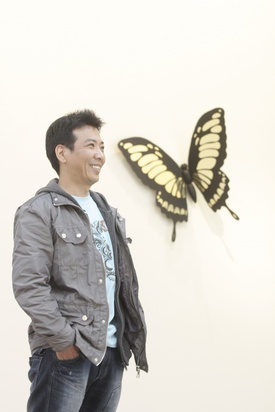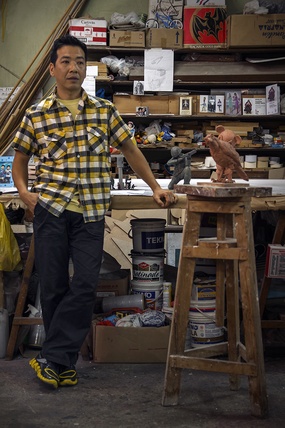2017 is a very special year for the plastic artist Haroldo Higa. With almost 25 years of career, in July, in the city of Arequipa, an exhibition with a selection of his works opens, while in November an exhibition in Lima will exhibit his new works.
Furthermore, in May, the First Nikkei Young Art Salon is held at the Peruvian Japanese Cultural Center, an initiative that he has promoted as a cultural manager, a new field in which he is gradually making headway.
An intense year full of challenges for an artist who refuses to classify his exhibition in Arequipa as a retrospective (he prefers to refer to it as a recount) because he feels that he still needs filming. “The concept of retrospective is more in line with great masters who have marked a milestone in art,” he says. “I still feel very young.”
Haroldo defines himself as “an artist who is in the process of growth. “I am in a stage of constant evolution.” Its November exhibition will be titled “Evolution.”
“AYAYAY, WHAT ARE WE GOING TO DO WITH HIM”
As a child he liked to draw and create things with his hands. I fantasized a lot. He had a parallel world in his head. Art had already nestled in him, but it would not be until his third year of studies at the Catholic University of Peru that he decided to become a sculptor.
Haroldo is the fifth of six brothers. When he decided to specialize in sculpture, the four eldest were studying traditional careers: business administration, accounting, law and economics.
“Suddenly I arrived, the one who knows nothing, the lazy one, the relaxed one, the one who had a shot in the head. It became a tragedy when mid-career I switched to sculpture,” he recalls.
It is common to associate art with job and economic precariousness. When Haroldo's family found out about his decision, they believed that they were condemning themselves to a future of perpetual helplessness: "'Now we are going to have to protect him, to help him all his life, we are going to have to subsidize him for life' (laughter). They looked at me saying 'yayay, what are we going to do with him'. They were filled with doubts. I also had many doubts, I still have many doubts about what I do, but they are part of the risks, of the adventure that one wants to follow.”
Haroldo made the right decision. To choose, he looked inside. "It was a very personal decision, a decision in which I looked at my heart and said 'what do I want to do?' And my heart told me that I had to be an artist.”
His parents and siblings managed to understand that he was on the right path. In that way? The reason was obvious. “They saw me happy, they valued my happiness.”
A COMBATIVE ARTIST
Although when he was at university Haroldo dreamed of becoming a great artist, he never imagined he would go this far. He says that he is not yet an established artist, but he is satisfied with what he has achieved and prides himself on his perseverance. “I am a combative artist, an artist who does not give up, who continues to look for possibilities, who does not want to stop creating.” In addition, he has added two facets to his work profile that consolidate him as a multidisciplinary professional artist: teaching and cultural management.
Haroldo teaches at the university where he studied. Teaching appeared as an opportunity and he has taken a liking to it. Contributing to training new artists and having his students see him as a reference fills him with satisfaction.
“What I like about teaching is being able to transmit the passion that I feel for art, being able to teach the student that art is a powerful tool to transform society,” he says. Art transforms consciousness, which in turn translates into positive things for society, he explains.
A romantic view of art, he admits. However, it also provides its students with tools so that they can respond to the demands of the labor market as managers or entrepreneurs, for example, and not only as artists in galleries or museums.
CHIP CHANGE
For Haroldo Higa, style is a shackle. As an artist in constant motion, he is always exploring new paths. Well, it wasn't always like this. The first ten years of his career he was devoted exclusively to wood, to a single way of making art.
“When you are young you think that you can achieve everything, that you can conquer the world. When I was young I said 'I want to become the master of wood,'” recalls the 48-year-old artist.
“In that desire to become a master of wood, I realized that I stopped experimenting, knowing, I was on autopilot. After ten years I looked back and said to myself 'what am I doing? 'Am I making art or am I producing art?' I looked around me and my workshop was an art factory, and I said 'no, that's it.' I realized that I had to rethink everything, I had to reformulate myself. I felt pigeonholed, pigeonholed by myself, by the market, by the work, artistic context, in short.”
Haroldo decided to broaden his vision, to discover the world that was outside the confines of himself. “In that change of chip, in that change of formulation of my gaze, I realized that I wanted to start exploring as a totally new artist, with new materials, new ways of creating, converting my workshop no longer into a production center. , but in an art laboratory.”
Since then, for fifteen years now, he has been an artist of risks, of adventures. And he enjoys it. “I decided to leave my comfort zone and enter a high-risk zone, and I realized that I began to like the risk more than the comfort. Today I always try to approach my new works from discomfort, from uncertainty, from doubt. That doesn't mean that I'm going to be successful, what it means is that it makes me feel alive, it's telling me that I still have the strength to continue working, that I see the future with optimism, because I feel that I'm in good shape, that there is still enough fuel. That makes me young. “I feel with that strength and enthusiasm of the young man, but with a less naïve look, with a mature look at reality.”
THE BEAUTIFUL AND THE UGLY
Several years ago, Haroldo declared that art is one of the most “beautiful” careers, but also one of the most “fucked up.” He couldn't explain himself then, but now he does.
First, the good. Art is a beautiful career because “it requires constant communication with your inner self, a relationship with what you feel deeply, how you see life and all that.”
Creating a work is talking to yourself, he explains. Thanks to art, “you are getting to know yourself and you are evaluating who you are. What the artist does is communicate to the viewers what he thinks. My job is to shape what I feel, what I think, and that is wonderful.”
Second, the bad. For him it is frustrating when there is no communication with the public, when his work fails to build bridges with people. That, from the artistic point of view. From a work perspective, the ugly thing is that it is very difficult to make a living from art in Peru. For this reason, he affirms, the artist has to “know how to work in any field, diversify.”
Sometimes Haroldo thinks that he would like to dedicate himself 100% to his workshop. However, he clarifies, “it is nice to miss the workshop; If you miss it, it's because it's worth continuing, that's good."
WHEN LIFE KEEPS SURPRISING YOU
Haroldo has the excitement of a new father regarding the First Nikkei Young Art Salon, which within the framework of the celebrations for the 50th anniversary of the Peruvian Japanese Cultural Center will exhibit the work of eleven young Nikkei artists. He hopes that the initiative will take root and become an annual event in which Nikkei artists from other countries will later participate. “I would love for it to be international, it would be wonderful to build that network,” he says.
His task in managing the exhibition demonstrates his strong ties with the Nikkei community. “Nikkei is a concept that some will feel and others will not. I have always had a very strong identity with the Nikkei. My family has always been closely linked to the cultural management of the community, and has had active participation within the leadership. It is very difficult not to feel that bond, it is very difficult not to feel Nikkei.”
“I am married to an Argentine Nikkei (Erica Yonamine), who is a Japanese dance teacher and is doing incredible work within the community. We are very identified, we have the Nikkei shirt on,” he adds. “I feel proud to be Peruvian and to be Nikkei.”
Haroldo and Erica have two children, eight-year-old twins. He loves to talk about them. “Every day they teach me something,” he reveals.
His children play a lot of sports and he likes that because “athletes are healthy and disciplined” and he trusts sports as a vehicle to transmit values and ethics. Are they artistically inclined? “Hopefully not,” he responds, laughing.
“My family is the most important thing I have,” he says. They have expanded the meaning of happiness, taking it to levels unsuspected by him. “Before having my children I thought I was the happiest person in the world—living with my wife, dedicating ourselves to the two of us—but since my children were born I realized that the concept of happiness is something much bigger. , that happiness is more immense, more, bigger. Seeing your children being born was like one thing... woooooo, it was a giant heart you had never known. That's nice, when you realize that life can still surprise you."
© 2017 Enrique Higa









